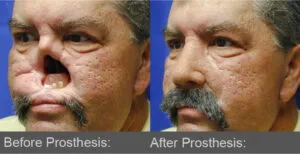When art and science come together, prosthetics are more than just tools for recovery. They are custom works of art that push the limits of what is acceptable in medical aesthetics. For a great example of how creativity and usefulness are coming together, look at the tailored prosthetics that are used to rebuild faces after head and neck cancer surgery.
Each limb is a custom design that is made with great care to fit each patient. First, the material is carefully shaped and formed. Next, it is carefully painted and coloured to match the personality and skin tone of the patient. These prosthetics go against what most people think of as art. They are expressive works of art that are carefully made to help people who have had major facial surgery regain both function and form.
In contrast to traditional art, which usually tries to elicit positive responses, these prostheses are made to hide features that might cause negative reactions. The most beautiful thing about these gadgets is that they serve a moral purpose: they make patients’ lives easier by letting them live more normal lives without drawing attention to their medical past.
Gaut’s study of beautiful things makes us seriously question the moral beauty of these prostheses. In contrast to traditional art, their goal is not to make you feel a certain way. Instead, they want to improve the patient’s health and happiness. To this end, they make important contributions to the patient’s health because they are different.
As part of the research, whether the piece helps people learn something new is also looked at. In fact, learning about how complicated these devices are can help you understand how complicated the human face is. It becomes a memorial to the people who worked so hard and with such great skill to make these amazing prosthetic wonders.
The fourth question goes into more depth about the work’s morality and how well it looks. In response to facial prosthetics, people should act in a way that is both aesthetically pleasing and ethically sound. These devices make the patient’s overall health much better by making them look better and easing their pain.

Lastly, an important thing to think about is how the art can inspire people to behave in a moral or ethical way. The prosthetic is a strong example that stops people from being mean to people who have hurt their faces and encourages kindness and sensitivity. In the area of medical aesthetics, the prosthesis is seen as more than just a pretty thing; it’s a symbol of persistence, knowledge, and the power of art to change things when things are hard.
By making these prosthetic miracles, artists go beyond their practical purpose and create symbols that show how strong the human spirit is and how powerful imagination can be when facing problems that can change a person’s life.
